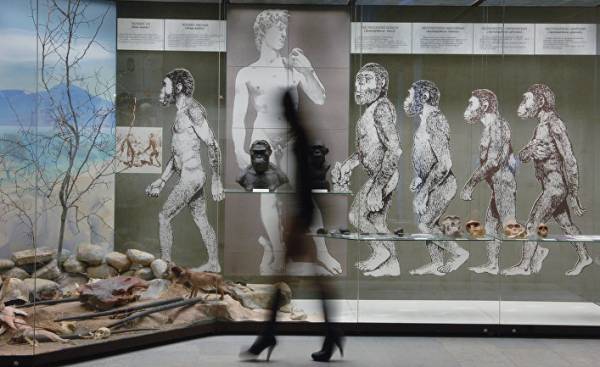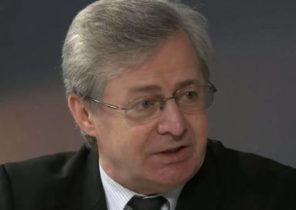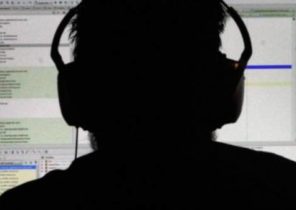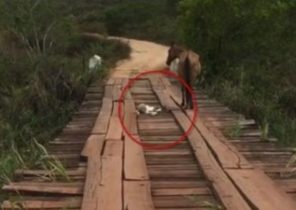
Translation carried out by the project Newочем
Among amphibians the Salamander Hydromantes species — the champion on speed of firing of the language. In less than five milliseconds it can catch the unfortunate insect in flight — this includes the muscles, cartilage and parts of skeleton. If you compare this ballistic anatomy of frogs and chameleons, the latter will be slowpoke. David Wake, an evolutionary biologist at the University of California at Berkeley, says: “I spent about 50 years studying the evolution of languages salamanders. This is really interesting, because generally they are fast, but nevertheless can make the rapid movement of those that are available vertebrates known to me”. Throughout their development, evolution has found a more efficient way to ensure a successful hunt with the help of language. Their seemingly unique adaptation of independently developed in three unrelated species of salamanders. This is an example of convergent evolution, when different species independently from each other under the influence of the same environmental factors develop similar biological adaptation. Salamanders — a favorite example that Wake leads when he asked long-standing question of evolutionary biology: if the “rewind the tape” of evolution, whether it will repeat itself? Apparently, in the case of salamanders and so it happened; with other organisms such could not happen.
It is known that this question was first put recently deceased evolutionary biologist Stephen Jay Gould in 1989 in his book “wonderful life: the Burgess Shale and nature of history,” which was published in an era when people still listened to music on audio cassettes. It tells about the fossils found in the Burgess shales left over from a myriad of strange animals that lived about 520 million years ago, during the Cambrian period. Almost all animals that exist today have ancestors that lived in the Cambrian, but not all animals from that era have descendants in our era. Many of the Cambrian species are extinct because it is not sufficiently suited for the struggle for survival, or because they were in the wrong place at the wrong time when volcanoes were erupting, falling meteorites, or were other devastating events.
Gould saw an incredible variety of animal remains in the Burgess and made the assumption that our flora and fauna would look different if history turned the other way. He suggested that the chaotic mutation and extinction of species, which he called “historical accidents” that builds on top of each other, moving evolution in one direction or another. According to Gould, the existence of any animal, including humans is a rare phenomenon, the repetition of which, in the case of “rewind and run” since the Cambrian period, unlikely. In his book, Gould often refers to a work on fossil Burgess, written by paleontologist Simon Conway Morris from Cambridge University, but the scientist disagrees with the point of view of Gould.
Conway Morris believes that over time, natural selection leads organisms to undergo a number of adaptations to fill a limited number of ecological niches of the Earth. This leads to the fact that unrelated types consistently converge in the structure of the body. “Animals have to build themselves in accordance with physical, chemical, and biological requirements of the world,” he said. Conway believes that such limitations make it virtually inevitable by the fact that in the case of “rewind film” evolution sooner or later would have led to the emergence of organisms similar to those that exist in our world. If our APE ancestors had not evolved brain and its accompanying mind, according to the scientist, another branch like a crow or dolphins could occupy a niche, which is now. But Gould disagrees.
Both scientists recognize that accidents and convergence (independent development until the appearance of similar signs — approx. Newочем) are the place to be in evolution. Instead, the discussion focused on how unique or repeated key adaptation like the human mind. And yet other biologists engaged in solving the puzzle and showed how convergence and randomness affect each other. Understanding of the interaction of these forces can help to understand whether all living the result of lucky coincidences for 7 billion years, or all of us — both people and salamanders — part of the inevitability of death and taxes.
Instead of trying to reconstruct history through fossils, Richard Lenski, an evolutionary biologist from the University of Michigan, decided to observe the phenomenon of convergence and contingencies in real time in a controlled environment of his laboratory. In 1988 he divided the population of Escherichia coli bacteria and put it in 12 separate tanks with liquid nutrient medium, thus allowing them to evolve independently from each other. For the past 26 years every few months he or one of his students freeze one serving bacteria. This set of frozen microbes gives Richard the opportunity to “restart the film” life cycle of Escherichia coli from any moment what he wills, and he simply defrost one of the portions. Throughout the process, he could test how the bacteria is changing — both in terms of genetics and in terms of what can be seen only under the microscope. Lenski explains: “the Whole experiment was set up to test how repeatable evolution”.
11 tanks Lenski E. coli grew in size, but the bacteria in the twelfth sample was divided into two independent branches — one with large cells, the other with small. Lenski says: “We call them “big” and “small”. They co-exist for 50 thousand generations.” In no other population that has not happened; hence, we can conclude what happened evolutionary random event. And even after 26 years no other sample did not repeat the appearance of such a branch. Thus, in this situation, the accident apparently took precedence over convergence.
In 2003, there was another random episode. The number of sticks in one of the basins had increased to such an extent that the nutrient medium, which is normally transparent, dimmed. First, Lansky decided that there was a common contamination of the environment, but as it turned out, E. coli, which normally ate only dissolved in liquid glucose, developed the ability to consume another element contained in the tanks: citrate. After 15 years and 31 500 generations only one of the colonies were able to recycle this material. The number of bacteria in it began to grow 5 times faster than in other colonies.
This “historical accident” gave Richard and his graduate Zachary Blount the opportunity to test the possibility of recurrence of such events, if they “rewind the tape”. Blount picked from storage 72 samples of frozen sticks collected at different stages of the experiment from a population that could later turn into your metabolism of citrate. He thawed them and stimulated their proliferation. Soon 4 of the 72 samples developed the same ability to consume citrate. Interestingly, these mutations occurred only in populations frozen after cycle 30 500 generations. Genetic analysis showed that shortly before several genes have gone through changes which have contributed to the evolution of citrate metabolism. In other words, the ability to absorb citrate depended on the appearance of other mutations that preceded it. This created a fork in the road, altering the possible ways in which you will be able to go to future generations.
Known as the “Long-term evolutionary experiment”, this project with Escherichia coli, up to this point have crossed the mark of 60 thousand generations, giving Richard a serious data set from which to draw conclusions about the interaction of chance and convergence in evolution. Hardly discernable change in the DNA of bacteria, making them larger or capable of rapid reproduction, have become a frequent event in various tanks. At the same time Lansky witnessed the “striking” of random events, in which one population was something totally different from the other. But as the phenomenon of convergence of such transformation was not in the full sense of random.
“Not everything is possible”, whatever the process, explains Wake: “Organisms evolve in the context of inherited characteristics.” Animals can’t pass on mutations that are fatal or prevent reproduction. In the case of the Salamander Hydromantes species her ancestors had to overcome a significant limitation: in order to shoot their languages, it was necessary to sacrifice light. This is because part of a mechanism that evolved from muscles, which were used by their predecessors for the injection of air into the lungs. Today this once small and weak muscle became bigger and stronger. She’s like a spring wound around a cone-shaped bone at the rear of the oral cavity, and when the muscle contracts, the bone creates tension, which shoots a language together with its osseous apparatus from the mouth. Thus, the ancestors of Hydromantes not just acquired a mutation that evolved into “ballistic tongue”. Instead, this adaptation follows the first set of changes, which at first enabled the creature to overcome the dependence of oxygen from the lungs to stay on the surface of the water. Each change depended on prior.
Chameleons, in turn, retained the lungs. Instead of having to alter their anatomy, they have developed collagen, allowing you to shoot the tongue in the production. At first glance, the tongues of salamanders and chameleons — an example of convergence, but if you look closely, it becomes clear that it is not. The shot required a chameleon 20 milliseconds, compared with five milliseconds of salamanders snail’s pace. Why the chameleon got such a slow language? Answer: they are faced with the obstacle of convergent evolution. Chameleon language fast enough that they could survive, but they have no “structure inherited hell” for the development of more lethal ballistic anatomy of salamanders. Chameleons have reached the “adaptive peak”, as the biologists would say.
In experiments with viruses that infect bacteria — bacteriophages — Harvard biologist David Liu also found adaptive peaks. These peaks limit the ability of organisms to converge on a single optimal structure. They explain why randomness is not repeated often.
Liu wanted to know whether identical groups of bacteriophages, independently from each other to develop the same enzyme, if they have the same evolutionary pressure. He accelerated protein evolution in viruses through the system, which he called “PACE” (PACE).
In the experiment, the viruses, failed to produce the enzyme needed BJ, removed from the experience. Had only achieved a goal. Someone of them the enzyme turned out “better” than the other. In this case, they were required to the enzyme polymerase, detecting a certain DNA sequence and turns it into RNA, and some polymerase to recognize the sequence more precisely than others. Like a relatively slow language. these viruses evolved adaptation that allows them to survive, but do not allow them to get the best polymerase. Some viruses stuck on a low peak, some climbed up.
To understand what biologists mean by adaptive peaks, imagine a landscape, a topography which represents the high and low levels of reproductive potential. In the case of bacteriophages Liu, different populations studied this area, acquiring different mutations. Some were in small hills, some in the mountains the size of Everest. And so they started up it inherited the top. Perched on a low hill, the viruses can’t move to another, higher. To do this they will first have to go back down, with each step reducing your chances of survival. It is very difficult, because the survival of the fittest should not be forgotten. Which mutation will happen before the other — which will go to the top of the body — this is a historical accident that convergent evolution can be overcome only with great difficulty, if at all.
The time of appearance of mutations has significance. “Early random events that create the difference in the gene pool, can greatly affect whether useful mutation ultimately affect the survival of an organism, — explains Liu. — The chance to reduce the repeatability of evolution.” In this experiment, the randomness is overcome convergence. The event prevented the recurrence.
One of the ways in which life can overcome the limitations of adaptive peaks, was opened in the study of digital organisms, computer biology, Michigan state University, Chris Adami and Charles Ofria. They created a computer program Avida in which digital organisms evolve under conditions set by the experimenter. “Avidity” mutate randomly gaining and losing lines of code, enabling them to solve mathematical problems, which enhances their ability to reproduce.
In one experiment, aviditas was given the task to the ability, allowing to solve the complex logical problem “bitwise identity”. Only 4 of 50 digital populations was developed needed to perform the operation code. All successful populations initially received a lot of mutations (random lines of code), complicating the solution of mathematical problems and, therefore, reproduction. It sounds paradoxical, but Ofria found that early bad mutations play a key role in improving the fitness of later generations, perhaps due to the fact that they create genetic diversity from which can emerge new random mutation.
Does the rarity of any of the sequences of events that major turns in the evolution are unlikely to be repeated? Judging by the experiments, it is, but Conway Morris firmly answers “no”. “It is foolish to assume that there are no those or other accidents. The only question in time.” He believes that with enough time and genome mutation natural selection will bring life to the inevitable adaptations that are best suitable for the ecological niches of organisms, despite arising accident. He believes that one day all of the bacteria Escherichia coli in the Lenski experiment will start to absorb the citrate and all viruses Liu will climb your Everest. Moreover, these experiments were conducted in a very simple and controlled environments, not reaching any comparison with a complex ecosystem, which adapts to life outside the laboratory. It’s hard to say what would have changed the experiments the influence of the real world.
By far the largest shortcoming of all attempts to answer the question about the tape of life that biologists can draw conclusions on the basis of only one biosphere Earth. Meeting with an extraterrestrial organism would tell us a lot. Even if alien organisms will not have DNA, they are likely to show similar patterns of evolution. They will need a material that is passed to offspring, guiding the development of organisms and change with time. As Lenski says, “what is true for Escherichia coli is true for the microbes in the Universe.”
Therefore, the same interaction between convergence and coincidence can be observed on other planets. And if extraterrestrial life is experiencing evolutionary pressure environment similar to that of experiencing life on earth, the people of the future can discover aliens, convergent, develop intelligence similar to ours. On the other hand, if random events are accumulated, taking the development of life in unique ways, as suggested by Gould, extraterrestrial life can be very strange.
Gould believed that humans are “extremely improbable evolutionary event”. As evidence, he pointed to the fact that over 2.5 billion years of life on Earth the human intellect appeared only once. He considered the likelihood that another species will develop intelligence similar to ours, ghostly small. That we may be the only intelligent species in the Universe, to draw conclusions, going beyond biology. “Some believe it’s a possibility that the reason for depression, wrote Gould in “Wonderful life.” “I have always found it invigorating, a source of freedom and, consequently, moral responsibility.”







